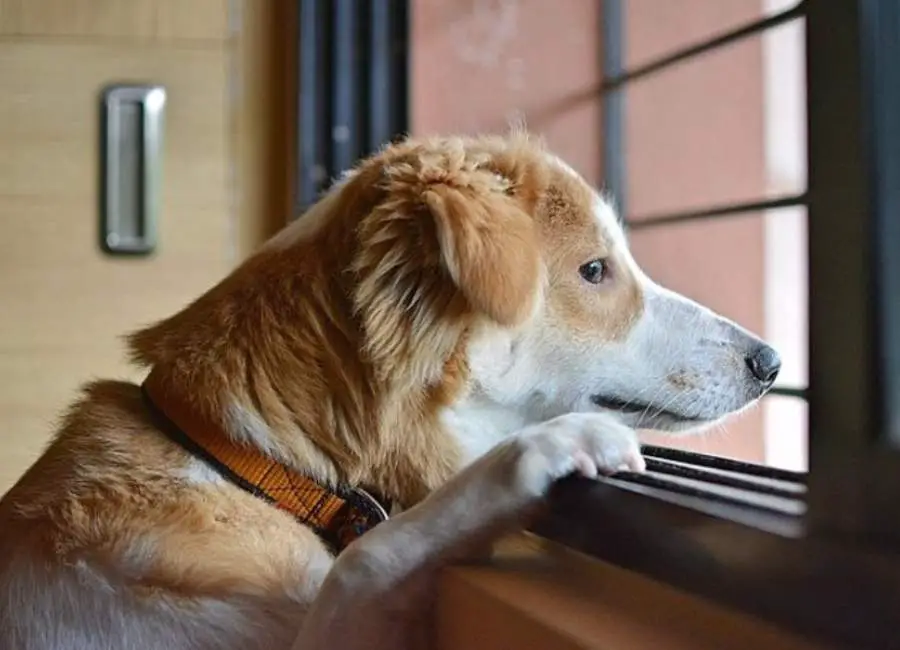12 Most Common Signs Your Dog Has Anxiety

Are you worried that your furry friend might be suffering from anxiety? Let’s talk about signs your dog has anxiety…
As much as we love our dogs, they can’t always tell us what’s wrong. That’s why it’s important to know the signs of anxiety in dogs.
From pacing and shaking to drooling and licking, there are many behaviors that could indicate your dog is feeling anxious.
In this blog post, we’ll explore some common signs of anxiety in dogs and provide tips on how to help your pup relax.
Signs Your Dog Has Anxiety
Here are some of the most common signs your dog has anxiety and tips to help your pup:
Restlessness
Dogs who have problems falling asleep or calming down may be anxious.
They can pace, whine, or show other indicators of agitation, which makes it challenging for them to unwind and acquire the rest they require.
Make sure your dog gets lots of exercises and mental stimulation, and think about utilizing calming aids to help your dog unwind and calm down, like a pheromone diffuser or an anxiety vest.
You can focus on putting training into practice to assist your dog in settling down on a specific area, like a mat or bed.
Learn more about how to make your dog feel safe.
Excessive licking or chewing
Dogs who compulsively lick or chew on themselves may be anxious.
This activity may call for veterinarian assistance and might cause skin irritation or infections.
To assist reduce anxiety, give your dog lots of mental and physical stimulation.
To reroute your dog’s chewing tendency, think about using a spray with a bitter taste or giving them suitable chew toys.
Learn more about why your dog licks you so much.
Excessive clinginess
Dogs who experience anxiety may develop excessive levels of clinginess or need, requiring their owners’ continual attention and comfort.
Their worry and fear of being parted from their owners may be the cause of this.
By progressively extending your absences, you can train your dog to feel at ease being by themselves.
Give autonomous and peaceful behavior plenty of praise and encouragement.
When you’re not home, keep your dog entertained and occupied with interactive toys and puzzles.
Increased sensitivity to sound or touch
Anxious dogs may become too sensitive to touch or sound, which can cause them to become fearful or aggressive.
Their increased level of vigilance and stress may be the cause of this.
Avoid touching or making triggering noises that make your dog uneasy.
Make sure your dog has a cozy, safe place to go when they’re feeling stressed.
Pacing
The usual anxiety symptom in dogs is pacing back and forth.
It may happen when people are anxious or stressed, bored or inactive, or for other reasons.
To prevent boredom and lessen tension, provide people with lots of exercise and mental stimulation.
Train your dog to choose a comfortable spot, and praise it for remaining calm.
Destructive behavior
Dogs who destroy furniture or other items could be anxious.
When the dog is left alone or in response to a trigger, such as loud noises, strange persons, or other animals, this behavior may manifest.
Make sure your dog gets enough exercise and mental stimulation, and provide them with safe, suitable chew toys.
If you plan to leave your dog alone for an extended period of time, think about utilizing a crate or a specific area to keep them contained.
Excessive barking or howling
When they are anxious or stressed, dogs may bark or howl excessively.
When they are left alone, in strange situations, or come across what they regard as a threat, they may act in this way.
Frequent barking or wailing may also be a sign of deeper problems like boredom, resentment, or fear.
To help combat boredom and lower tension, give your dog lots of mental and physical stimulation.
Give them the “silent” instruction and praise them for being composed.
When you’re away, think about employing white noise or music to calm them.
Whining
Excessive whining or whimpering in dogs could indicate nervousness or discomfort.
If you find that your dog is whining more frequently than normal, it’s crucial to watch out for additional symptoms of worry, such as restlessness or avoidance.
Determine the root of your dog’s whimpering and take the appropriate action.
Try giving your dog a safe haven to withdraw to, like a crate or a designated room, if their whimpering is a result of worry.
Also, you might think about utilizing relaxing tools like an anxiety vest or a pheromone diffuser.
Learn more about how to bond with your dog.
Trembling or shaking
A sign of nervousness in your dog could be shaking or trembling.
It’s crucial to remember, though, that dogs might tremble or shake for other causes as well, such as fear, excitement, or cold weather.
Once more, it’s crucial to determine the underlying reason for your dog’s trembling or shaking.
If it’s caused by nervousness, think about introducing training or utilizing soothing techniques to make your dog feel more secure and at ease in their surroundings.
Hiding or cowering
As a coping mechanism for their nervousness or fear, dogs may try to hide or cower.
When they come across something that they regard as a threat or when they are in an unfamiliar or unpleasant situation, this behavior might be observed.
Provide your dog with a cozy sanctuary, such as a box or a quiet room, where they can hide out.
If your dog is feeling uncomfortable, don’t make them socialize with people or other animals.
Learn more about preventing separation anxiety in dogs.
Panting or excessive drooling
In dogs, panting or profuse drooling may indicate nervousness.
They might act in this way as a result of a difficult scenario, while they’re feeling stressed or anxious, or both.
It’s critical to keep an eye on their breathing and drooling to make sure that neither becomes excessive, which could be an indication of additional health problems.
Give your dog access to cool water and a relaxing spot.
Try to recognize and stay away from your dog’s anxiety-inducing triggers.
Loss of appetite
When worried or anxious, dogs with anxiety disorders may lose their appetite or develop fussy eating habits.
This might occur as a result of their digestive system slowing down as a result of stress or motion sickness.
To get your dog to eat, provide him with food that is both delicious and healthy.
Take your dog to the vet if their lack of appetite continues so that any underlying medical conditions can be ruled out.
Learn more about the signs of separation anxiety in dogs.
What to do if you suspect your dog has anxiety
It’s recommended to speak with a veterinarian if you think your dog may be anxious.
Your dog’s health issues can be diagnosed and ruled out by the veterinarian.
They can also assist you in creating a treatment strategy that matches your dog and your way of life the best.
Exercise, physical contact, and the use of positive rewards are some methods for calming a nervous dog.
The veterinarian might recommend medicine for more severe anxiety disorders.
It’s crucial to avoid punishing dogs for exhibiting anxious behaviors as this can make them feel even more uncomfortable.
Learn more about helping your dog not to run away.
Environmental triggers for anxiety in dogs
Abandonment, anxiety over being alone at home, loud noises, travel, and being among unusual people, kids, or animals are a few environmental anxieties triggers for dogs.
Stress and anxiety can also be brought on by changes in their environment.
Due to their keen hearing, dogs are most frequently stressed by environmental triggers that involve noise.
Exercise and early experiences can also be linked to anxiety and personality issues in dogs.
Fear and anxiety in dogs can also result from being forced into an unsettling situation or from being isolated from social interactions and their surroundings.
Conclusion
In conclusion, it’s critical to observe your animal friend’s behavior and watch out for indications of distress.
Bear in mind that stress and anxiety can affect pets just like they do humans.
You can assist your dog to unwind and feel more at ease by being aware of the symptoms of anxiety in dogs.
There are several strategies to reduce your dog’s anxiety, including training, exercise, and professional assistance.
Furthermore, keep in mind the numerous advantages pets can have in our lives, such as lowering stress and anxiety.
Thus, take good care of both the physical and mental health of your furry friend, and relish all the benefits of owning a pet.
